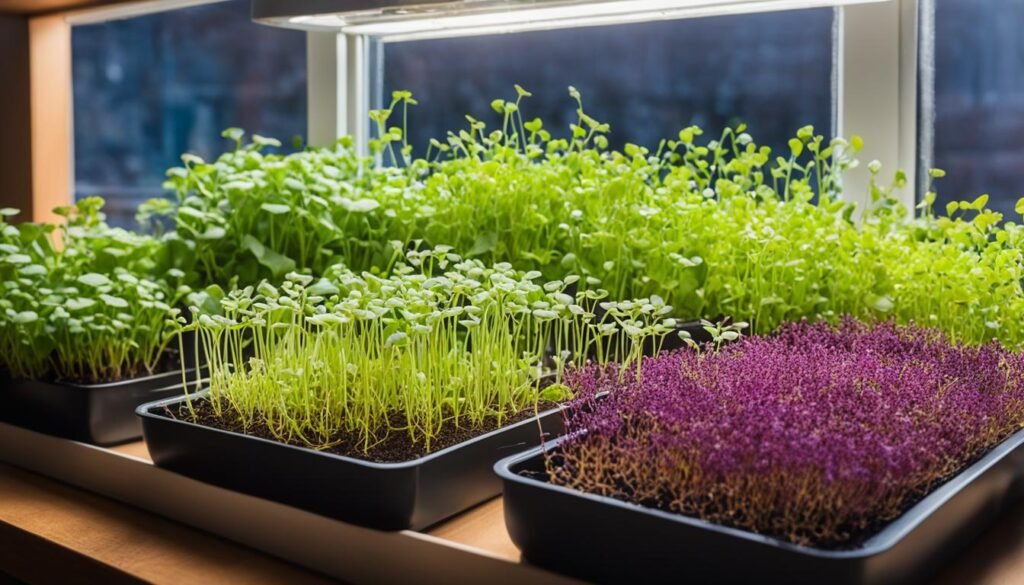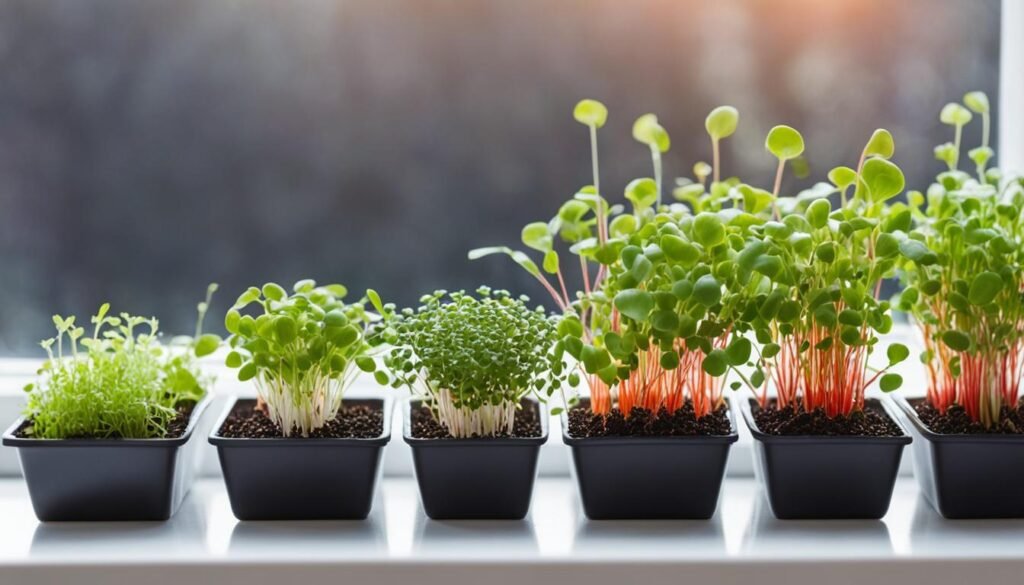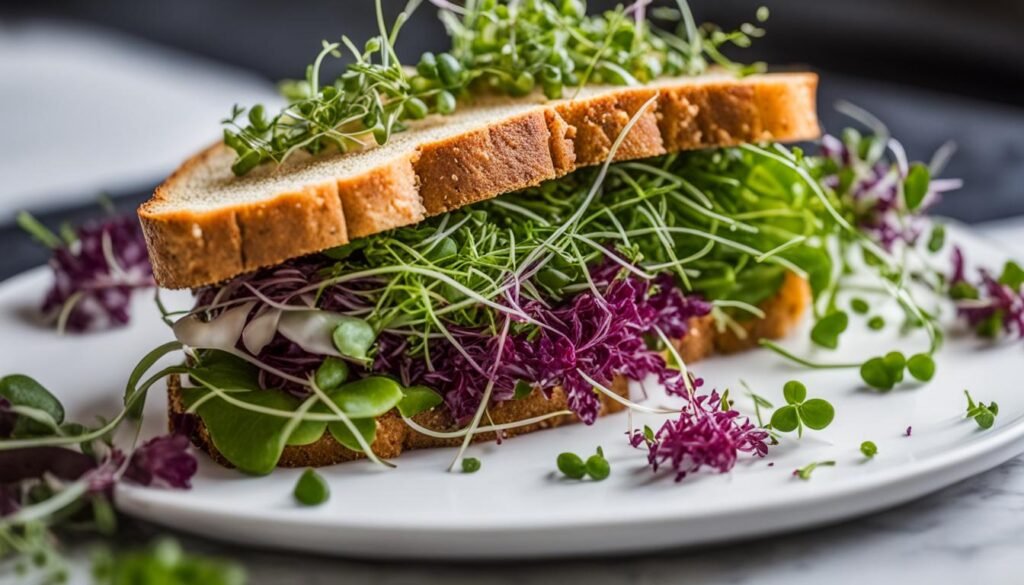Today, I’m excited to share with you the world of indoor gardening and the wonderful realm of microgreens. Growing microgreens indoors has become increasingly popular, and for a good reason. These nutrient-dense greens are packed with flavor and vitamins, and they can be grown right in the comfort of your own home.
Microgreens are essentially young, tender greens that are harvested at an early stage of growth, making them perfect for indoor gardening. They have a quick growth cycle, allowing you to enjoy a continuous supply of fresh greens throughout the year. Whether you have limited outdoor space or simply want to have control over your growing conditions, an indoor microgreen garden is a fantastic option.
Not only are microgreens easy to grow indoors, but they also offer a range of benefits. By having your own indoor microgreen garden, you can save space, eliminate the use of pesticides, and ensure a year-round supply of fresh greens. Plus, these vibrant little greens add a burst of flavor and a touch of elegance to any dish.
In this article, I will highlight the best microgreens to grow indoors and provide you with essential tips for successful indoor microgreen gardening. We’ll also explore the rise of microgreens in modern kitchens, their incredible nutritional benefits, and different ways to incorporate them into your daily diet. By the end, you’ll be inspired to unlock the endless potential of microgreens in your kitchen garden.
Key Takeaways:
- Microgreens are nutrient-dense greens that are ideal for indoor gardening.
- Growing microgreens indoors allows for year-round supply and control over growing conditions.
- Microgreens offer numerous benefits, including saving space and ensuring freshness.
- In this article, we will explore the best microgreens to grow indoors and tips for successful indoor microgreen gardening.
- Incorporating microgreens into your daily diet adds flavor, nutrition, and visual appeal to your meals.
The Rise of Microgreens in Modern Kitchens
In recent years, there has been a significant rise in the popularity of microgreens, and they have become a staple in modern kitchens. These small but mighty greens have gained recognition not only for their vibrant flavors and delicate textures but also for their exceptional nutritional benefits.

Discovering the Nutritional Powerhouse of Microgreens
Microgreens are the young seedlings of vegetables and herbs, harvested when they are at their most nutrient-dense stage of growth. They are packed with a concentrated array of vitamins, minerals, and antioxidants, making them a true nutritional powerhouse. Studies have shown that microgreens can contain up to 40 times more nutrients than their mature counterparts, making them an excellent addition to any diet.
Why Microgreens Are the Perfect Fit for Urban Dwellers
With the rise of urbanization and limited space for traditional gardening, microgreens have become a perfect fit for urban dwellers. These greens can be easily grown indoors, requiring minimal space and resources. Whether you live in a city apartment or a small house, you can effortlessly cultivate microgreens on your windowsill or kitchen countertop. They provide a convenient and sustainable way to enjoy homegrown greens without the need for a large garden.
Transitioning from Gourmet Restaurants to Home Cuisine
Microgreens were once predominantly seen in gourmet restaurants, where they were used as elegant garnishes and sophisticated flavor enhancers. However, their popularity has transcended the dining scene, and they have found their way into home cuisine. Home cooks have discovered the versatility of microgreens, incorporating them into a variety of dishes, from salads to sandwiches and even using them as a vibrant topping for soups. Microgreens add a burst of freshness and visual appeal to homemade meals, elevating the dining experience.
| Microgreen Variety | Flavor Profile | Nutritional Benefits |
|---|---|---|
| Pea Shoots | Delicate and sweet | High in vitamin C, protein, and folate |
| Sunflower Greens | Nutty and crunchy | Rich in vitamin E, antioxidants, and minerals |
| Radish Microgreens | Peppery and tangy | Good source of vitamin B6, iron, and potassium |
| Broccoli Microgreens | Mild and slightly bitter | Abundant in sulforaphane, a powerful antioxidant |
| Cilantro Microgreens | Fresh and citrusy | Rich in vitamin K, antioxidants, and essential oils |
| Arugula Microgreens | Peppery and nutty | High in vitamin A, calcium, and magnesium |
| Basil Microgreens | Aromatic and herbaceous | Contains essential oils with antimicrobial properties |
Essential Tips for Growing Microgreens Indoors
When it comes to successful indoor microgreen gardening, following essential tips can make all the difference. Here are some key guidelines to help you create a thriving microgreen garden right in the comfort of your own home:
- Choose the right containers: Select shallow containers or trays with drainage holes to ensure proper water drainage and prevent mold or root rot. Plastic or ceramic containers are ideal for maintaining moisture levels.
- Select the appropriate soil: Opt for a lightweight and well-draining soil mix specifically formulated for microgreens. Avoid using garden soil, as it may contain pests or diseases that can hinder growth.
- Ensure proper watering: Water your microgreens regularly to keep the soil evenly moist, but not waterlogged. Use a spray bottle or a gentle watering technique to avoid displacing seeds or damaging delicate shoots.
- Provide adequate lighting: Microgreens require ample light for photosynthesis. Place them in a well-lit area, near a sunny window or under grow lights. Aim for 12-16 hours of light per day to promote healthy growth.
- Maintain optimal temperature: Most microgreens thrive in temperatures around 65-75°F (18-24°C). Avoid exposing them to extreme heat or cold, as it can inhibit germination and slow down growth.
- Practice proper harvesting: Harvest microgreens when they have reached the desired height, usually within 7-14 days. Use a clean pair of scissors to cut the shoots just above the soil level. Rinse them thoroughly before consumption.
By following these essential tips, you can enjoy a successful indoor microgreen garden and have a constant supply of fresh and nutritious greens at your fingertips.

| Tips for Growing Microgreens Indoors | Indoor Microgreen Gardening Tips | Successful Indoor Microgreen Gardening |
|---|---|---|
| Choose the right containers | Select the appropriate soil | Ensure proper watering |
| Provide adequate lighting | Maintain optimal temperature | Practice proper harvesting |
Best Microgreens to Grow Indoors
When it comes to growing microgreens indoors, there are several varieties that thrive in a controlled environment, allowing you to enjoy fresh greens year-round. Here are some of the best microgreens to grow indoors:
Pea Shoots: The Sweet Addition to Your Indoor Garden
Pea shoots are delightful microgreens with a sweet and tender flavor. They are packed with vitamins A and C, as well as fiber, making them a nutritious addition to any dish. Pea shoots are easy to grow indoors and can be harvested when they are about 2 inches tall.
Sunflower Greens: Nutty Flavor and Crunch in Every Bite
Sunflower greens are known for their nutty flavor and satisfying crunch. These microgreens are rich in vitamins B, D, and E, as well as iron and zinc. Sunflower greens are quick to grow and can be harvested when they develop their first set of true leaves.
Radish: A Peppery Punch for Spicy Food Lovers
If you enjoy a bit of heat in your dishes, radish microgreens are perfect for you. These spicy greens add a peppery punch to salads, sandwiches, and stir-fries. Radish microgreens are a great source of vitamins A, B, C, and K, as well as minerals like calcium and potassium.
Broccoli Microgreens: Tiny Greens, Immense Health Benefits
Broccoli microgreens are a powerhouse of nutrition, containing high levels of vitamins A, C, and K, as well as sulforaphane, a potent antioxidant. These miniature greens have a mild and slightly nutty flavor, making them a versatile addition to salads, smoothies, and wraps.
Cilantro: Infuse Freshness into Every Dish
Cilantro microgreens are beloved for their vibrant green color and refreshing flavor. They add a burst of freshness to Mexican, Asian, and Mediterranean cuisines. Cilantro microgreens contain vitamins A and K, as well as antioxidants that support overall health.
Arugula: Bold and Peppery Greens in Just Days
Arugula microgreens are prized for their bold flavor, combining a peppery taste with a hint of nuttiness. These greens are rich in vitamins A, C, and K, and their small size makes them perfect for adding a zesty kick to salads, sandwiches, and pasta dishes.
Basil and Beyond: Adding Herbs to Your Microgreen Mix
While not a true microgreen, basil is a popular herb that can be grown indoors alongside your microgreen garden. Its aromatic leaves are perfect for adding a burst of flavor to pasta dishes, pizzas, and soups.
Remember, these are just a few examples of the best microgreens to grow indoors. There are many other varieties to explore and experiment with, allowing you to create a diverse and flavorful indoor microgreen garden.

Garnishes: Use microgreens as garnishes to add a pop of color and freshness to your dishes. They can be sprinkled on top of soups, stews, or roasted vegetables to enhance the presentation and taste.
Stir-fries: Toss microgreens into stir-fries during the last few minutes of cooking to preserve their delicate flavor and texture. They will add a burst of freshness to your favorite stir-fry recipes.
Smoothies: Blend microgreens into your favorite smoothies for an extra dose of nutrients. Their mild flavor blends well with fruits and vegetables, making them a nutritious addition to your morning routine.
Juices: Add microgreens to freshly squeezed juices for a vibrant boost of vitamins and minerals. They can take your homemade juices to a whole new level of freshness and flavor.
Remember to properly wash and store microgreens before using them in your dishes. Ensuring food safety and freshness is essential to fully enjoy the benefits of microgreens in your daily diet. Get creative and experiment with different ways to incorporate these nutrient-rich greens into your meals!
Conclusion
Unlocking the endless potential of microgreens is a transformative experience for indoor gardeners. Throughout this article, we have explored how growing microgreens indoors offers numerous benefits and opens up a world of possibilities. From their exceptional nutritional value to their versatility in the kitchen, microgreens have become a staple in modern homes.
Growing microgreens indoors allows you to complete the full cycle of indoor gardening – starting from gathering tiny seeds to watching them grow into vibrant greens and finally savoring the harvest in your favorite dishes. It’s a gratifying process that brings nature into your home and allows you to connect with your food like never before.
Your kitchen garden will never be the same again. With microgreens, you can add vibrant colors, intense flavors, and powerful nutrients to your meals. Whether you’re garnishing salads, enhancing sandwiches, adding depth to stir-fries, or even blending them into smoothies and juices, microgreens have the ability to elevate every dish.
What Are the Best Microgreens to Grow in the Recommended Soil Choices for Indoor Gardening?
When it comes to choosing the top soil choices for microgreens, many indoor gardeners opt for organic potting soil, coconut coir, or a mix of vermiculite and perlite. These options provide the necessary nutrients and drainage for microgreens to thrive in an indoor environment. basil, chard, and radish are among the best microgreens to grow in these recommended soil choices for indoor gardening.
Source Links
- https://www.urbanmali.com/blogs/wisdom/the-best-microgreens-for-indoor-gardening
- https://microgreensworld.com/top-30-microgreens-you-can-easily-grow-indoors/
- https://www.bhg.com/types-of-microgreens-8402632

